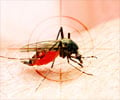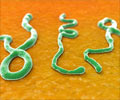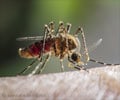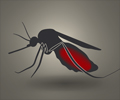- Disease - (http://www.cdc.gov/malaria/about/disease.html)
- Malaria - (https://www.niaid.nih.gov/diseases-conditions/malaria)
What is Malaria?
Malaria is caused by a parasite that enters blood through the bite of an infected mosquito.
Malaria is a serious parasitic disease and is carried to humans through mosquitoes infected with the protozoan parasite called Plasmodium. There are 5 species of Plasmodium (Malaria parasite) which infect humans:
- Plasmodium vivax
- Plasmodium falciparum
- Plasmodium malariae
- Plasmodium ovale
- Plasmodium knowlesi
Of these five, Plasmodium falciparum is the most deadly parasite.
An important fact about malaria is, only the female mosquitoes belonging to Anopheles genus act as vectors in carrying the disease. These mosquitoes blood feed on infected humans and contribute to the transmission of malaria. However, malaria is a non-contagious disease and does not spread directly from person-to-person.
Classification of Malaria
World Health Organization (WHO) classifies malaria into:
Uncomplicated Malaria
Uncomplicated malaria results in symptoms, but clinical tests do not indicate any vital organ dysfunction. This type of malaria goes through 3 stages:
- Cold stage (shivering)
- Hot stage (fever, vomiting, headaches)
- Sweating stage (sweating, tiredness)
Complicated or Severe Malaria
Severe malaria is caused mainly by P. Falciparum, and if left untreated, can result in organ failure. Severe malaria also causes anemia, cerebral malaria resulting in abnormal behaviour, acute respiratory distress syndrome, low blood pressure, acute kidney failure, hyperparasitemia and hemoglobinuria.
Though malaria is a treatable disease, the major concern is that malarial parasites are increasingly becoming drug resistant and thereby throw challenges in curbing the spread of the virulent disease.
The two groups mainly vulnerable to contracting malaria are - children who are below the age of five and pregnant women. During pregnancy, immunity to malaria reduces, making a woman more vulnerable to the disease.
In the year 2012, WHO put the malarial death figures at around 627 000, making it one the most fatal disease. Also, according to WHO, malaria death rates have decreased by 42% globally since 2000.
Life Cycle and Causes of Malaria
Malaria is spread through the bite of an infected female Anopheles mosquito.
An infected mosquito injects the parasites into the blood of a healthy person in the form of sporozoites. These sporozoites travel in the bloodstream to the liver, where they grow and multiply asexually without showing any symptoms in a person and produce forms known as merozoites.
Then, the parasites in the form of merozoites are released from the liver cells in vesicles that travel to the heart and settle in the lung capillaries. Eventually, in the lung capillaries, the vesicles disintegrate, freeing the merozoites into the blood stream.
In the blood stream, the parasites that are in the form of merozoites replicate asexually by creating daughter parasites, which invade and infect the red blood cells and thereby resulting in symptoms of malaria in an affected person.
Some parasites in the form of merozoites in the blood cells produce immature gametocytes through the process of sexual reproduction. These immature male and female gametocytes freely circulate in the blood stream.
If a mosquito takes a blood meal from an infected person, it ingests these immature gametocytes, which then develop into mature male and female sex cells known as gametes, in the gut of the mosquito.
These male and female gametes fuse to form ookinetes (a fertilized and motile form of malarial parasites in the body of mosquito), which penetrate into the mosquito midgut and form oocysts.
Each oocyst producing thousands of parasitic forms called sporozoites, bursts, releasing the sporozoites into the mosquito's body cavity, from where they travel to the salivary glands of the mosquito.
This vicious cycle re-starts when the mosquito with sporozoites in its salivary glands bites a healthy person.
Symptoms and Signs of Malaria
A patient with malaria usually goes through three stages, the cold stage, the hot stage and the sweating stage.
Malaria Symptoms are Characterized by:
- Shivering
- Fever
- Fatigue
- Headache
- Muscle pain
- Enlarged spleen
- Profuse sweating
- Nausea
These symptoms of malaria are seen only after a period of few days after the infectious bite, which is called as incubation period. The incubation period - after the bite and before showing of symptoms - varies anywhere between 7 and 30 days.
In case of severe malaria, the symptoms include:
- Altered consciousness
- Convulsions
- Severe anemia
- Breathing difficulties
- Prostration
- Limited urine production
Diagnosis of Malaria
Diagnosis is based on clinical symptoms and tests like microscopic examination and rapid diagnostic tests. Newer tests are also available.
Though a symptomatic disease, diagnosis of malaria is difficult in non-endemic areas, as clinicians may mistake these symptoms to be of any other disease like flu or viral infection.
For a speedy diagnosis, a modern method called Rapid Diagnostic Test (RDT) is employed. In this technique, blood specimen of the patient with certain reagents is applied to the sample pad on the test card. When observed after 15 minutes, any presence of specific bands in the test card window proves that the patient is infected with any of the four species of human malaria.
The other new and advanced malaria diagnosis tests include quantitative buffy coat method and Polymerase based detection method.
Diagnosis of Malaria is also done using two conventional methods:
- Clinical Diagnosis
Clinical diagnosis is based on the physical examinations and symptoms.
- Microscopic Diagnosis
In comparison to the first method, microscopic diagnosis is more scientific and is conclusive; wherein, a drop of patient’s blood is spread out as a blood smear and is examined under a microscope.
Prior to examination, Giemsa staining of the blood smear is carried out, to give the parasite a unique appearance when seen under microscope.
Prevention of Malaria
Malaria can be prevented by avoiding mosquito bites and taking steps to prevent breeding of mosquitoes.
Personal protection from the bite of infected mosquitos and environmental management play a major role in malaria prevention.
Precautions to be Taken to Prevent Malaria
Precautions that are advised to prevent malaria include:
- Wearing long sleeves clothes, especially in the late evening
- Use of mosquito repellents
- Indoor residual spraying
- Taking anti malaria pills
- Use of bed nets
Travelers to areas affected with malaria are usually advised to take preventative anti-malarial drugs like mefloquine (Lariam), primaquine, atovaquone/proguanil (Malarone).
Steps should also be taken to prevent breeding of mosquitoes. These include:
- Since mosquitoes breed in stagnant water, do not allow water to stagnate around your residence.
- Small fish called gambusia are introduced into pools and other stagnant water sources since these fish eat up the mosquito larvae growing in the water.
Hitherto, there is no availability of malaria vaccine that has proved to be 100 percent effective. However, PfSPZ vaccine, touted as a totally effective vaccine against malaria is still under clinical trial and is yet to be put into clinical practice.
Treatment for Malaria
Malaria is treated with anti-malarial drugs. Drug resistance is an important consideration while treating malaria.
Before initiating malaria treatment, various factors like type of infecting parasite, patient’s clinical status, drug allergies and the place where infection was acquired, should be taken into consideration.
After ascertaining the above, depending on the type of malarial parasite and severity of disease, antimalarial drugs have to be taken.
Artemisinin-based combination therapies (ACTs) are adopted in the treatment of P. falciparum malaria.
Also, chloroquine is an important anti-malaria medication used in the treatment of P. vivax infections in the areas that have not developed drug resistance.
In case of severe malaria, artesunate can be given to the patient through injection, either intravenous or intramuscular. The major drugs used in the treatment of malaria include:
- Artemether
- Artesunate
- Chloroquine
- Mefloquine
- Quinine plus doxycycline or pyrimethamine / sulfadoxine
Prognosis of Malaria
Early diagnosis and administering antibiotics and other malaria medications reduce the effect of malaria. Otherwise, malaria is a life-threatening disease, mainly in children. Malaria in children causes anemia, and several bouts of malaria can cause developmental impairments.
Malaria due to plasmodium falciparum infection can result in severe anemia, due to destruction of red blood cells (erythrocytes).


















